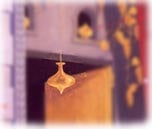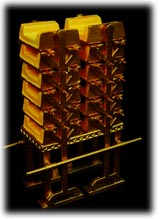The Kodesh - Inner Sanctuary
The doorway of the Kodesh was 10 cubits wide and 20 cubits high. Over the doorway was a carving of a golden menorah donated by Queen Helena, a convert to Judaism.
 The
morning service could not begin before sunrise. The Temple was
surrounded by high walls, and it was not possible to see the rising sun,
so a priest had to be sent outside to see if it was time for the
service to begin.
The
morning service could not begin before sunrise. The Temple was
surrounded by high walls, and it was not possible to see the rising sun,
so a priest had to be sent outside to see if it was time for the
service to begin.
 The Doorway
The Doorway
 The Windows
The windows of the Kodesh were 20 cubits high, and consisted of long
narrow openings in the walls. The openings were wider on the outside
than on the inside. In a private dwelling, window openings were narrow
on the outside and wide on the inside to cause the light to spread
inside. The rabbis viewed the Heichal as the "light source" of the
world, so the windows were constructed thus to spread the light outward.
The Windows
The windows of the Kodesh were 20 cubits high, and consisted of long
narrow openings in the walls. The openings were wider on the outside
than on the inside. In a private dwelling, window openings were narrow
on the outside and wide on the inside to cause the light to spread
inside. The rabbis viewed the Heichal as the "light source" of the
world, so the windows were constructed thus to spread the light outward.
 The Holy Vessels
Near the northern wall of the Kodesh was the Shulchan (Golden Table).
It was placed in an east-west orientation. On the Table were the twelve
showbreads and two spoons filled with frankincense. There were the
other golden tables in the Kodesh; five north of the Golden Table, and
five to the south. These were to enhance the beauty of the Golden Table.
The Holy Vessels
Near the northern wall of the Kodesh was the Shulchan (Golden Table).
It was placed in an east-west orientation. On the Table were the twelve
showbreads and two spoons filled with frankincense. There were the
other golden tables in the Kodesh; five north of the Golden Table, and
five to the south. These were to enhance the beauty of the Golden Table.
 In the First Temple, a wall 1 cubit thick separated the Kodesh from the Holy of Holies.
In that Temple the ceiling was only 30 cubits, the Second Temple had a
height of 40 cubits between floor and ceiling. A wall 1 cubit thick
could not be erected to the 40 cubit height. They did not want to make a
wider wall so as not to diminish any area of the Kodesh or the Holy of
Holies.
In the First Temple, a wall 1 cubit thick separated the Kodesh from the Holy of Holies.
In that Temple the ceiling was only 30 cubits, the Second Temple had a
height of 40 cubits between floor and ceiling. A wall 1 cubit thick
could not be erected to the 40 cubit height. They did not want to make a
wider wall so as not to diminish any area of the Kodesh or the Holy of
Holies.
The doorway of the Kodesh was 10 cubits wide and 20 cubits high. Over the doorway was a carving of a golden menorah donated by Queen Helena, a convert to Judaism.
 The
morning service could not begin before sunrise. The Temple was
surrounded by high walls, and it was not possible to see the rising sun,
so a priest had to be sent outside to see if it was time for the
service to begin.
The
morning service could not begin before sunrise. The Temple was
surrounded by high walls, and it was not possible to see the rising sun,
so a priest had to be sent outside to see if it was time for the
service to begin.
After Queen Helena donated the Menorah, it was no longer
necessary to send a priest outside the Temple. As the sun rose in the
east it shone against the menorah and the reflected light was cast into
the Azarah. The priests then knew that the morning service could begin.
 The Doorway
The Doorway
The doorway was 6 cubits thick and had four doors. The
doors were made of olive wood overlaid with gold. Carved in the gold
were angels, palm trees, and flowers. The front walls of the Heichal and
the doorposts were 6 cubits thick.
Two doors were set at the front of the 6-cubit doorway,
and two doors were set at the rear. The front two doors opened inward,
and folded against the inner wall of the doorway.  The rear doors also opened inward, and folded against the wall. (R. Yehudah has a different opinion concerning the doors).
The rear doors also opened inward, and folded against the wall. (R. Yehudah has a different opinion concerning the doors).
 The rear doors also opened inward, and folded against the wall. (R. Yehudah has a different opinion concerning the doors).
The rear doors also opened inward, and folded against the wall. (R. Yehudah has a different opinion concerning the doors).
In front of the doors was a curtain that could be raised and lowered. When the High Priest was in the Kodesh, the curtain was lowered to afford him privacy.
 The Windows
The Windows
The Kodesh was 40 cubits long, 20 cubits wide and 40
cubits high. The walls were paneled with wood and overlaid with gold,
except for the places the doors covered when they were open. Engraved in
the gold were palm trees, vines, flowers, and angels.
 The Holy Vessels
The Holy Vessels
The Menorah was placed with a north-south orientation near the southern wall  of
the Kodesh, though some say it was placed with an east-west
orientation. There were ten other menorahs in the Kodesh. Five were
placed north of the Menorah, and five were placed to the south. These,
too, were from ornamental purposes.
of
the Kodesh, though some say it was placed with an east-west
orientation. There were ten other menorahs in the Kodesh. Five were
placed north of the Menorah, and five were placed to the south. These,
too, were from ornamental purposes.
 of
the Kodesh, though some say it was placed with an east-west
orientation. There were ten other menorahs in the Kodesh. Five were
placed north of the Menorah, and five were placed to the south. These,
too, were from ornamental purposes.
of
the Kodesh, though some say it was placed with an east-west
orientation. There were ten other menorahs in the Kodesh. Five were
placed north of the Menorah, and five were placed to the south. These,
too, were from ornamental purposes.
In the center of the Kodesh was the golden Altar. The
Menorah, Altar, and Table were placed within the inner half of the
Kodesh. The Altar was slightly off to the east.
 In the First Temple, a wall 1 cubit thick separated the Kodesh from the Holy of Holies.
In that Temple the ceiling was only 30 cubits, the Second Temple had a
height of 40 cubits between floor and ceiling. A wall 1 cubit thick
could not be erected to the 40 cubit height. They did not want to make a
wider wall so as not to diminish any area of the Kodesh or the Holy of
Holies.
In the First Temple, a wall 1 cubit thick separated the Kodesh from the Holy of Holies.
In that Temple the ceiling was only 30 cubits, the Second Temple had a
height of 40 cubits between floor and ceiling. A wall 1 cubit thick
could not be erected to the 40 cubit height. They did not want to make a
wider wall so as not to diminish any area of the Kodesh or the Holy of
Holies.
It was decided to build the Kodesh a full 40 cubits long
and the Holy of Holies a full 20 cubits. A neutral space of 1 cubit
would be place between them, and marked off by two curtains.
One curtain was placed between the end of the Kodesh and
the beginning of the cubit space. The other curtain was placed between
the end of the cubit space and the beginning of the holy of Holies. The
outer curtain was folded back on its southern side and the inner curtain
folded back on its northern side.
The curtains were never opened except during festivals,
when they were rolled back so that the people could see the carvings of
the angels on the wall. The angels in the carvings were embracing, which
represented the love of G-d to the children of Israel.
No comments:
Post a Comment